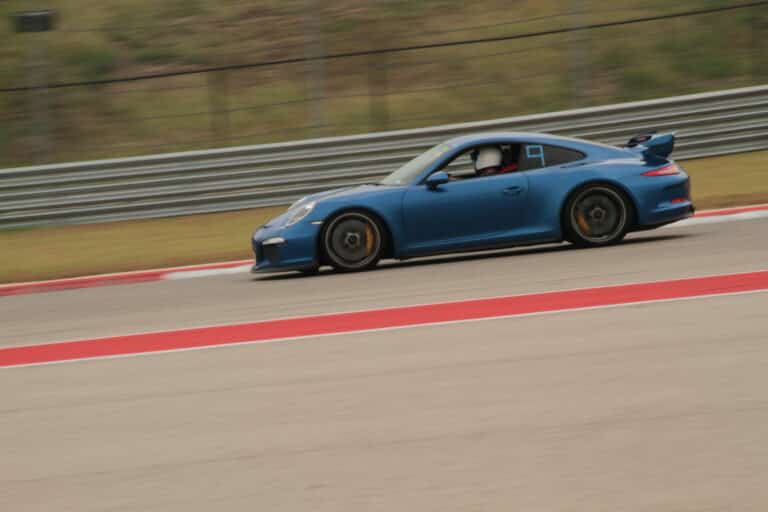
Upshifting
Upshifting should be done smoothly. Speedshifting will shorten the gearbox life. The only time I force an upshift is in a side by side race to the next corner, for position. I will sometimes “bang a gear” in an effort to take or hold a position. Listen to the in-car shifts of professional racers on TV, and they rarely bang shifts. Upshifts are done quickly and smoothly, but are not forced. If you want your gearbox to have a long, happy life, feel the gears, the changes should fall in, without being forced.
Downshifting
The first thing to understand is the purpose of the downshift. It is not to slow the car, that is the job of the brakes. The purpose of downshifting is to have the car in the correct gear to accelerate through and out of the corner.
Here is the process:
As you enter the braking zone, apply the brakes, but do not immediately downshift. The downshift should be done after the RPM’s have dropped, but must be complete before you begin the turn-in. Downshifting too early can over-rev the motor, waiting too long means you will be rolling the car through the corner entry, giving up the ability to use the throttle to balance the car.
Heel toe Downshifting
Why is “Heel toe” important? Remember, as you approach the traction limit of your tires, anything that takes traction can cause the car to slide. Have you ever downshifted and released the clutch too quickly and felt the car jump as the engine RPM’s were forced up to match the cars speed? Kind of like tapping the brakes. Think of this, if you are driving at 70 mph in 4th gear, at 4000 rpm’s and shift down to 3rd, your engine rpm’s will go up, to say 5200 rpm’s. You can accomplish this by easing out the clutch, until the engine is forced up in rpm’s by the car. This works, but it is slow, hard on the clutch and transmission synchros, and uses up some of your traction to force the RPM’s up. The alternative is to match the engine speed to the transmission speed (in the lower gear). This can be done by pushing in the clutch, blipping the throttle, selecting the lower gear and releasing the clutch. The problem is, downshifting is done at the same time we are braking. Guess what, we have two feet and three pedals to operate simultaneously! The Heel Toe technique solves this problem.
“Heel toe” is a misnomer. It can be done in many ways, depending on the pedals in the car, and the anatomy of the driver. Although it can be, it is not usually done with the heel and toe. The process is commonly done by placing the ball of the foot on the right side of the brake pedal, and while holding consistent brake pressure, the side of the foot rolls onto the throttle, “blipping” the throttle. Depending on your anatomy, and the pedals, it can be done any way that allows the brakes to be used while the throttle is blipped.
Heel Toe cannot be done smoothly unless two things are done:
1) The pedals must be matched. Normally this is done by adjusting until the brake and throttle are even in height, when the brakes are pressed on. The pedals must also be properly spaced. In my car it required adjusting and bending the gas pedal until I got the match I needed. In many cars, the pedals have some range of adjustment, making the process easier. One thing to remember, as you adjust the gas pedal, make sure that there is a mechanical stop for the pedal. If you rely on the stops in the carburetor or injection system to stop the motion, you will probably bend or break something as you try to squeeze a couple more horsepower out of the pedal. Also, make sure the linkage allows the butterflies in the carburetor to be fully open when the pedal hits your mechanical stop.
2) The technique must be practiced. Do not come to the track, with the intention of learning to Heel Toe. Learn the technique on the street, and practice it until it is second nature, before trying it at the track. If your street car is different from your track car, and your street car has a manual transmission, set its pedals for Heel Toe, and learn the technique. Try to get the pedal arrangement similar for both cars. If you must learn the technique in your track car, make it low on your priority list. When driving the line is second nature, you are comfortable in traffic, you’ve got all of the corner stations figured out, start working on it.
Heel Toe is not a required skill at your first event or two, as a matter of fact, you don’t ever have to learn it. It is a tool that will make you a smoother driver (ie. faster!), and you will be easier on your equipment. It’s a tool to add to your arsenal of skills as your high performance driving becomes more polished.
By Dev Clough
What is weight transfer? A car, at rest, distributes its weight over...
Some people believe that an occasional spin or crash is essential to...
Many drivers believe that the key to driving quickly is to drive...
The line is the path around the track, that when driven at...
Learn the essential rules of passing during HPDE events to ensure safety...
Whether your goal is to run HPDE or to be the next...
Now that you have signed up for the HPDE, you need to...
After much prodding from my friends I finally committed to going to...